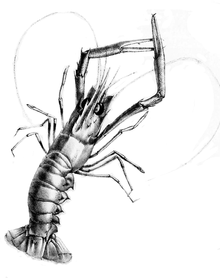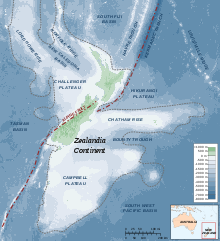- Metanephrops challengeri
-
Metanephrops challengeri 
Illustration of M. challengeri by C. S. Bate (1888) Scientific classification Kingdom: Animalia Phylum: Arthropoda Subphylum: Crustacea Class: Malacostraca Order: Decapoda Family: Nephropidae Genus: Metanephrops Species: M. challengeri Binomial name Metanephrops challengeri
(Balss, 1914)Synonyms Nephrops challengeri Balss, 1914
Metanephrops challengeri (the New Zealand lobster or New Zealand scampi) is a species of lobster from New Zealand. It was first collected by the Challenger expedition of 1872–1876, but only described as separate from related species by Heinrich Balss in 1914. Although originally classified in the genus Nephrops, it was moved in 1972 to a new genus, Metanephrops, along with most other species then classified in Nephrops. It is an important fishery species, and under the limitations of New Zealand's Quota Management System, trawlers catch around 1000 t per year.
Contents
Distribution and ecology
Metanephrops challengeri lives around the coasts of New Zealand, including the Chatham Islands, at depths of 140–640 metres (460–2,100 ft).[1] It lives in burrows in a variety of "suitable cohesive" sediments,[2] and is a significant prey item for ling, Genypterus blacodes.[3] Lobsters have few parasites,[4] the most important for M. challengeri being the microsporidian Myospora metanephrops, which can cause "destruction of the skeletal and heart muscles of infected lobsters".[5] When it was described in 2010, M. metanephrops was the first microsporidian to be isolated from a true lobster.[4]
Description
Metanephrops challengeri is a slender pink lobster,[6] typically 13–18 centimetres (5.1–7.1 in) long, but exceptionally up to 25 cm (9.8 in),[1] and weighing up to 100 grams (3.5 oz) each.[6] It is one of the two most aberrant species in the genus Metanephrops, the other being Metanephrops neptunus.[7] M. challengeri is considered to have the most primitive morphology of any species of Metanephrops, having even fewer novelties than the oldest known fossil species, M. rossensis.[7] Its rostrum is longer than that of other species in the thomsoni species group, and the ridge along the midline of the carapace only has two small spines.[7][8]
Fisheries
 Continental shelf areas of New Zealand. Scampi fishing is focused on the Campbell Plateau. The Alpine Fault and the limits of the submerged continent Zealandia are also marked.
Continental shelf areas of New Zealand. Scampi fishing is focused on the Campbell Plateau. The Alpine Fault and the limits of the submerged continent Zealandia are also marked.
Metanephrops challengeri has been harvested commercially since the 1980s. Between the season of 1988/89 and 1990/91, the amount of scampi caught around New Zealand increased from only 55,000 kilograms (120,000 lb) to around 500,000 kg (1,100,000 lb).[9] Catch limits were introduced in 1990/91,[9] and now 1,000,000 kg (2,200,000 lb) is caught annually by trawlers.[5] The fishery is centred on four areas of continental shelf of the submerged continent Zealandia: the Campbell Plateau around the Auckland Islands, Chatham Rise, along the Wairarapa coast, and in the Bay of Plenty.[9]
Most of the fishing vessels used to capture M. challengeri are 20–40 metres (66–130 ft) long, with "double or triple trawl rigs of low headline height".[2] There is considerable variation in the catch per unit effort between different depths, between different geographical areas and between different years.[2]
Metanephrops challengeri was the subject of a 2003 select committee inquiry in the New Zealand parliament, after allegations of corruption arose against officers of the Ministry of Fisheries. Although the allegations were quashed, the inquiry ruled that preferential treatment had been given to the large fishing company Simunovich Fisheries.[6] In response, the government introduced M. challengeri into their Quota Management System[10] and paid compensation to some fishermen who had a justified grievance.[11] Under QMS, an overall limit of 1,291,000 kg (2,850,000 lb) was put in place for M. challengeri in 2011.[12]
Taxonomy
External identifiers for Metanephrops challengeri EOL 346024 ITIS 552935 WoRMS 382850 Also found in: SeaLifeBase, GBIF Metanephrops challengeri was first described by Heinrich Balss in 1914, under the name Nephrops challengeri.[1] Two specimens had been collected on the Challenger expedition from benthic Globigerina ooze at a depth of 275 fathoms (1,650 ft; 503 m), on the Challenger Plateau in the Tasman Sea (38°50.5′S 169°20′E / 38.8417°S 169.333°E).[1] They had been included by Charles Spence Bate in his report on the crustaceans collected by the Challenger expedition, but were not separated from M. thomsoni, which was described by Bate as a new species. Balss recognised that Bate's M. thomsoni covered two species and, restricting the name M. thomsoni to the species containing the type specimens designated by Bate (from the Philippines), and creating a new species for the species from New Zealand. Balss chose the two specimens seen by Bate to be the type specimens of his new species, Nephrops challengeri.[13] Both were females, and they have been deposited at the Natural History Museum in London.[1]
The species was transferred to a new genus, Metanephrops (along with every other extant species then in Nephrops, except its type species, Nephrops norvegicus) by Richard Jenkins of the University of Adelaide in 1972.[14] Jenkins placed M. challengeri among the "thomsoni group" within the genus Metanephrops, alongside M. thomsoni, M. sibogae, M. boschmai and M. sinensis.[14] Jenkins inferred that this group of species had originated off northern Australia or in Indonesia, and that M. challengeri had reached New Zealand in the late Tertiary and displaced M. motunauensis, which formerly lived there.[14] More recently, findings from molecular phylogenetics suggest that M. challengeri has a basal position in the genus, possibly linked to M. neptunus, and that the genus may have originated at high latitudes in the South Atlantic.[7]
References
- ^ a b c d e Lipke B. Holthuis (1991). "Metanephrops challengeri". Marine Lobsters of the World. FAO Fisheries Synopsis No. 125. Food and Agriculture Organization. p. 72. ISBN 92-5-103027-8. http://nlbif.eti.uva.nl/bis/lobsters.php?menuentry=soorten&id=96.
- ^ a b c M. Cryer, K. Downing, B. Hartill, J. Drury, H. J. Armiger, C. Middleton & M. D. Smith (2005). "Digital photography as a stock assessment tool for Metanephrops challengeri on New Zealand’s continental slope". In Ross Shotton. Deep Sea 2003: Conference on the Governance and Management of Deep-sea Fisheries. Part 1: Conference Reports, 1–5 December 2003, Queenstown, New Zealand. FAO Fisheries Proceedings. 3/1. Food and Agriculture Organization. ISBN 92-5-105402-9. http://www.fao.org/docrep/009/a0210e/a0210e0h.htm#bm17.
- ^ Matthew R. Dunn, Amelia M. Connell, Jeff Forman, Darren W. Stevens & Peter L. Horn (2010). "Diet of two large sympatric teleosts, the ling (Genypterus blacodes) and hake (Merluccius australis)". PLoS One 5 (10): e13647. doi:10.1371/journal.pone.0013647. PMC 2965093. PMID 21048962. http://www.pubmedcentral.nih.gov/articlerender.fcgi?tool=pmcentrez&artid=2965093.
- ^ a b G. D. Stentiford, K. S. Bateman, H. J. Small, J. Moss, J. D. Shields, K. S. Reece, I. Tuck (2010). "Myospora metanephrops (n. g., n. sp.) from marine lobsters and a proposal for erection of a new order and family (Crustaceacida; Myosporidae) in the Class Marinosporidia (Phylum Microsporidia)" (PDF). International Journal for Parasitology 40 (12): 1433–1446. doi:10.1016/j.ijpara.2010.04.017. PMID 20558169. http://www.vims.edu/people/small_jm/pubs/Stentiford%20Metanephrops.pdf.
- ^ a b Grant D. Stentiford & Douglas M. Neil (2011). Diseases of Nephrops and Metanephrops: a review. In Grant Stentiford. "Diseases of Edible Crustaceans". Journal of Invertebrate Pathology 106 (1): 92–109. doi:10.1016/j.jip.2010.09.017. PMID 21215358.
- ^ a b c Niel Bruce & Alison MacDiarmid (2 March 2009). "Lobsters, prawn and krill". Crabs, crayfish and other crustaceans. Te Ara: The Encyclopedia of New Zealand. http://www.teara.govt.nz/en/crabs-crayfish-and-other-crustaceans/5. Retrieved 13 June 2011.
- ^ a b c d Tin-Yam Chan, Ka Chai Ho, Chi Pang Li & Ka Hou Chu (2009). "Origin and diversification of the clawed lobster genus Metanephrops (Crustacea: Decapoda: Nephropidae)". Molecular Phylogenetics and Evolution 50 (3): 411–422. doi:10.1016/j.ympev.2008.11.020. PMID 19070670.
- ^ Dale Tshudy, Tin-Yam Chan & Ulf Sorhannus (2007). "Morphology based cladistic analysis of Metanephrops: the most diverse extant genus of clawed lobster (Nephropidae)". Journal of Crustacean Biology 27 (3): 463–476. doi:10.1651/S-2777.1.
- ^ a b c P. J. Smith (1999). "Allozyme variation in scampi (Metanephrops challengeri) fisheries around New Zealand". New Zealand Journal of Marine and Freshwater Research 33 (3): 491–497. doi:10.1080/00288330.1999.9516894.
- ^ Pete Hodgson (2 December 2003). "Scampi inquiry delivers thorough report". Ministry of Fisheries. http://www.fish.govt.nz/en-nz/Press/Press+Releases+2003/December+2003/Scampi+inquiry+delivers+thorough+report.htm. Retrieved 13 June 2011.
- ^ Anonymous (31 March 2005). "Another scampi fisher accepts compensation". Ministry of Fisheries. http://www.fish.govt.nz/en-nz/Press/Press+releases+2005/March+05/Another+scampi+fisher+accepts+compensation.htm. Retrieved 13 June 2011.
- ^ "Spiny red rock lobster (CRA)". New Zealand Fisheries information website. Ministry of Fisheries. http://fs.fish.govt.nz/Page.aspx?pk=7&tk=100&sc=CRA. Retrieved 4 April 2011.
- ^ J. C. Yaldwyn (1954/5). "Nephrops challengeri Balss, 1914, (Crustacea, Decapoda, Reptantia) from New Zealand and Chatham Island waters". Transactions of the Royal Society of New Zealand 82 (3): 721–732. http://rsnz.natlib.govt.nz/volume/rsnz_82/rsnz_82_03_008500.html.
- ^ a b c Richard J. F. Jenkins (1972). "Metanephrops, a new genus of Late Pliocene to Recent lobsters (Decapoda, Nephropidae)". Crustaceana 22 (2): 161–177. doi:10.1163/156854072X00426. JSTOR 20101873.
Further reading
- Report on the Crustacea Macrura collected by H.M.S. Challenger during the Years 1873–1876 by C. Spence Bate
Categories:- True lobsters
- Marine crustaceans of New Zealand
- Edible crustaceans
- Commercial crustaceans
- Animals described in 1914
Wikimedia Foundation. 2010.
